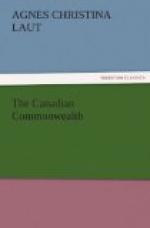What happened in Kootenay was largely repeated ten years later in Klondike and ten years yet later in Cobalt, and it must not be forgotten that when Canadian capital refused to bond the nickel mines of Sudbury, it was American capital that dared the risk.
What happened in the mining booms was only a faint foreshadowing of the furore that broke to a madness in real estate when American settlers began crossing the boundary in tens and hundreds of thousands a year. Canadians knew they had wonderfully fertile farming land. Hadn’t they been telling themselves so since confederation, when they pledged the credit of Canada to build a transcontinental? They knew they had the most fertile wheat lands on earth, but what was the use of knowing that when you could not sell those lands for fifty cents an acre? What was the use of raising forty bushels of wheat to the acre, when you burned it in the stack or fed it to cattle worth only ten dollars a head, because you could get neither wheat nor cattle to market? You really believed you had the best land on earth, but what good did the belief do you? Sons and daughters forsook the Canadian farmstead for the United States. Between the early eighties and the early nineties, of Canada’s population of five millions, over a million—some estimates place it at a million and a half—Canadians left the Dominion for the United States. You find the place names of Ontario all through Michigan and Wisconsin and Minnesota and the two Dakotas; and you find Jean Ba’tiste drifting from the lumber woods of Quebec to the Upper Peninsula of Michigan and to the redwoods of California and to the yellow pine uplands of the Southwestern Desert. I have met men who worked for my brothers in the lumber woods of Wisconsin down among the yellow pines of the Arizona Desert. All that was back in the decrepit and languid and hopesick nineties. It was then you could see the skies of Southern Manitoba luridly aflame at night with wheat stacks it didn’t pay to thresh.
Came a turn of the wheel! Was it Destiny or Providence? We talk mistily of Cause and Effect, but who drops the Cause that turns the Wheel? Who of us that witnessed the crazy gold stampede to Kootenay and the crazier stampede to Klondike could guess that the backwash of those foolish tidal waves of gold-mad humanity would people the Northwest? Why, we were mad with alarm over the gold stampede!




